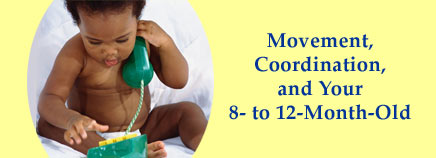
From scooting to crawling to cruising, babies learn how to get around during these months. So now is the time to childproof your home, if you haven’t already. Be especially careful to gate staircases and block off rooms that you’d rather your baby didn’t explore.
How Is My Baby Moving?
By now your baby is sitting and using his or her hands every so often for support. Once comfortable in this position, your baby will learn to turn and reach for objects without falling over. Your baby will also get better at changing positions, and soon figure out how to get into a sitting position, then pull up to stand.
When on the stomach, your baby will learn to push up onto the hands and knees and rock back and forth. This little “exercise” is working the arm and leg muscles, getting your child ready to propel forward (or backward) in an attempt to get moving.
Some babies are better at crawling than others so don’t worry if your child has developed some novel ways of getting around, including rolling, scooting on his or her bottom, or creeping.
As long as your baby is using the arms and legs on both sides of the body and shows an interest in exploring surroundings, there’s usually no reason to be concerned.
Leg muscles have gotten stronger from standing, bouncing, and crawling. Now is the time for your baby to start taking steps while holding on to the couch, coffee table, or other pieces of furniture for balance. This is called “cruising.” You can encourage it by holding your baby’s hands while your little one takes a few steps.
Fine motor and hand-eye coordination also continue to improve during this period, and your baby will develop the ability to pick up very small things, including cereal, with dexterity. This coordination can range from an awkward raking grasp to a precise finger-to-thumb pincer grasp.
Encouraging Movement
Give your baby safe areas to practice moving and many chances to move — limit the time your baby spends in strollers, cribs, and other equipment that restricts movement.
Allow for tummy time so your baby is in the right position to practice crawling. Help your baby get onto his or her hands and knees, put a favorite toy out of reach, and encourage your baby to move toward the desired object.
Encourage walking by letting your baby cruise along the furniture (remove or pad furniture with sharp edges), holding your baby’s hands while he or she practices, or using a sturdy walking toy or wagon. Walking toys usually have a bar that extends to about chest height on a baby and is attached to a stable, weighted base with wheels. The baby holds the bar for support and pushes the toy for movement. You’ll need to supervise this process, of course, and make sure stairs are blocked off.
When to Call the Doctor
Call your doctor if your child does not:
- crawl, creep, or scoot around
- stand when supported
- use both sides of his or her body equally
- seem to have good control of his or her hands
Normal child development tends to follow a certain pattern. The skills that babies develop early serve as building blocks for future skills. Still, the time it takes to develop these skills can vary widely among kids. If you’re concerned about your baby’s development, speak with your doctor.

